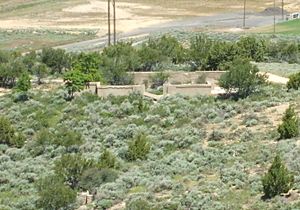Knightsville, Utah facts for kids
Quick facts for kids
Knightsville, Utah
Knightville
|
|
|---|---|

The foundation of the Knightsville School
|
|
| Country | United States |
| State | Utah |
| County | Juab |
| Established | 1896 |
| Abandoned | c. 1940 |
| Named for | Jesse Knight |
| Elevation | 6,742 ft (2,055 m) |
| GNIS feature ID | 1437606 |
Knightsville was a ghost town in Utah, United States. It was a small community built for people who worked in the silver mines. Knightsville was located in the East Tintic Mountains, about 2 miles (3.2 km) east of Eureka. It was started in 1896 by a mining boss named Jesse Knight and was active until around 1940. A "ghost town" is a place where most or all people have left, and it's now empty. A "company town" means the town was owned and run by the mining company.
Contents
History of Knightsville
In 1896, a man named Jesse Knight came to the Tintic Mining District. He didn't have much money or experience in mining. People who knew a lot about rocks and mines told him where not to dig. But Jesse Knight decided to dig a mine shaft anyway. He quickly found a lot of valuable ore, which is rock with metal inside. Because people had doubted him, he called his mine the Humbug Mine.
Jesse Knight opened several mines in the East Tintic area. He soon became one of the richest mine owners there. He was a member of the Church of Jesus Christ of Latter-day Saints. This was unusual because most mine owners were not. His success earned him the nickname "the Mormon Mining Wizard."
A Special Mining Town
Jesse Knight didn't like the typical mining towns. These towns often had a lot of problems like drinking and other bad habits. He decided to build his own town for his miners, close to the Humbug Mine.
He started Knightsville by building 20 houses on Godiva Mountain. Soon, the town grew to 65 homes and two boarding houses. Knightsville also had stores, churches, and hotels. It even had its own post office. But Knightsville was special because it was known as "the only mining camp in the United States without a saloon." Jesse Knight owned the land, and he would not allow any saloons to open in his town.
At first, the people of Knightsville paid taxes to Utah County. But in 1898, a new survey showed that the county line was just east of the town. So, starting in 1899, they began paying taxes as residents of Juab County.
"Uncle Jesse" and His Workers
Jesse Knight cared a lot about his workers and the people living in his town. He was the first mine owner in the area to close his mines on Sundays. He even paid his workers more each day to make up for the lost day of work. He wanted his miners, many of whom were Mormons, to go to church on their day off. Because of this, his mines were sometimes jokingly called the "Sunday School mines."
Knight also helped the town's school. When he found out there weren't enough children to get money from the county for the school, he hired a father with eight children. This made the school big enough to get funding!
Nearby Eureka had many saloons. But if an employee in Knightsville spent too much time drinking and ignored their family, Jesse Knight would talk to them. If they kept doing it, they could even lose their job. Many miners liked these rules. They affectionately called Jesse Knight "Uncle Jesse." By 1907, Knightsville had grown to about 1,000 people.
Decline of Knightsville
Around 1915, the valuable silver ore in Jesse Knight's mines started to run out. Because of this, some of the mines slowly began to close. Many houses were moved out of Knightsville, with some going to Eureka.
By 1924, only two mines were still working. By 1940, all the mining operations had stopped completely. The town of Knightsville became empty. Today, not much is left of the town. You can still see some old bits and pieces, and the foundation of the Knightsville schoolhouse. This foundation is an important historical site and is listed on the National Register of Historic Places.



